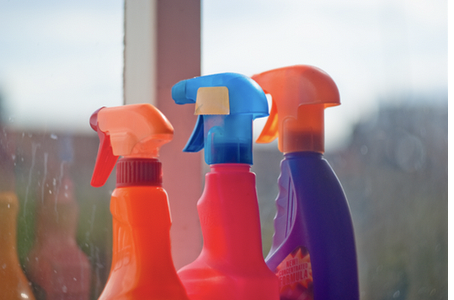Green Cleaning
New ResidentialWhat is Green Cleaning?
Green cleaning refers to using cleaning products and procedures that minimize potential adverse impacts on human health and the environment.[1] Cleaning with green or natural products can lower airborne particulate matter concentration and improve indoor air quality. Comprehensive green cleaning programs prioritize environmental and health issues as well as the appearance of the residence.

Figure 1 – Spray bottles (Source: Flickr fatedsnowfox http://www.flickr.com/photos/fatedsnowfox/4540384687/sizes/l/in/photostream/)
Some cleaning products can have human health impacts such as burns or respiratory or skin, eye, nose, throat problems on skin contact or through inhalation exposure, while others may contribute to long-term health problems such as cancer or disruption to the endocrine system. Chlorine bleach or ammonia, which are found in many toilet and drain cleaners, can be corrosive. These chemicals can cause immediate health problems upon skin and inhalation exposure as well as damage to the environment when they go down the drain.[2],[3] When harsh chemical use is necessary, use appropriate gloves to avoid or minimize skin exposure. It is also essential to have good air circulation in the room while cleaning and never mix two different types of cleaners, particularly if the products contain chlorine (bleach) and ammonia.[4]
Green cleaning prioritizes non-toxic cleaning products and low-impact cleaning equipment and reduces the risk of exposure to hazardous chemicals.[5] Green cleaning is not just about products but also about cleaning procedures such as using the appropriate quantity of the right product for a specific job or reducing the frequency of labor-intensive tasks by using less intensive cleaning and maintenance activities more often. Simple changes such as limiting food consumption to specific areas can reduce cleaning needs and can also be part of an integrated pest management plan, reducing the need for toxic pest management chemicals (see Integrated Pest Management). Green cleaning requires a holistic approach that includes the careful selection and use of products and equipment and a reevaluation of cleaning procedures.
How to Implement Green Cleaning
Develop a green cleaning program that prioritizes green or natural products and green cleaning practices (see Operator and Occupant Training).

Figure 2 – Natural Cleaning Products. (Source: Rutgers Center for Green Building)
The Healthy Children and Family Study, conducted by Rutgers University, found that the use of a mop with a microfiber cloth and the use of vinegar and baking soda as cleaners lowered airborne particulate matter concentration. Vacuuming with high-efficiency particulate air (HEPA) filters help remove particulate matter and volatile organic compounds from the air.[6]
Environmentally preferable purchasing (EPP) refers to products or services that have less impact on human health and the environment than competing products or services that serve the same purpose.[7] Choose environmentally preferable products that are rated green by independent, third-party organizations such as Greenguard, Green Seal, or US EPA’s Safer Choice program. It is also important to check product labels and Material Safety Data Sheets (MSDS). Custodial equipment, such as vacuums, and green cleaning services can also earn third-party certification through programs like the Carpet and Rug Institute Seal of Approval Program and Green Seal.
Benefits
Green cleaning offers the following benefits:
- Protects the health and safety of residents and cleaning professionals.
- Reduces toxic chemicals in the indoor and outdoor environment and reduce the amount of hazardous waste requiring disposal.
- Improves indoor air quality.
Costs
Over the long-term, green cleaning can reduce the total cost of cleaning through reducing or eliminating hazardous cleaning chemicals. Because there are fewer toxic chemicals that employees must work with, liability exposure also is reduced. Similarly, with fewer toxic chemicals to store, track, maintain and dispose of, the cost of complying with regulatory requirements is reduced.[8] The University of Georgia’s facilities cleaning program, implemented by the Physical Plant’s building services’ department, earned recognition for a focus on cost-saving and workplace safety. The program covers 9.7 million square feet and includes a Building Services Academy that trains all department employees in green cleaning policies and procedures.[9] The University of Georgia’s program documented benefits such as a decrease in employee respiratory complaints associated with cleaning chemicals, a decrease in the number of severe employee injuries from slips/falls, and significant cost savings from transitioning from traditional cleaners to green cleaners.[10] Although not limited to residential buildings, this example helps illustrate the benefits and cost reductions of green cleaning. Many green cleaning products are cost-competitive with traditional products, and green cleaning programs offer the added benefit of protecting human health and the environment.
Resiliency
Green cleaning reduces the use of toxic and hazardous chemicals and products that can pose health hazards to the public and damage to natural resources. Reducing the need to store toxic chemicals and products helps reduce the risk, and danger of toxic substances spills or releases into the environment during an extreme event such as flooding or other disasters.[11] Minimizing the risk of toxic material spills and leaks help protect the public as well as those engaged in clean up and remediation activities, making it easier to recover after an unexpected event.
[1] US EPA. Sustainable Marketplace: Greener Products and Services. https://www.epa.gov/greenerproducts/greening-your-purchase-cleaning-products-guide-federal-purchasers (accessed December 19, 2018).
[2] American Lung Association. Cleaning Supplies and Household Chemicals. https://www.lung.org/our-initiatives/healthy-air/indoor/indoor-air-pollutants/cleaning-supplies-household-chem.html (accessed December 19, 2018).
[3] US EPA. Sustainable Marketplace: Greener Products and Services. https://www.epa.gov/greenerproducts/greening-your-purchase-cleaning-products-guide-federal-purchasers (accessed December 19, 2018).
[4] Cleveland Clinic. Household Chemical Products and Their Health Risks. https://my.clevelandclinic.org/health/articles/11397-household-chemical-products-and-their-health-risk (accessed March 3, 2019).
[5] GSA. Sustainable Facilities Tool. https://sftool.gov/search?Query=green+cleaning (accessed December 19, 2018).
[6] Rutgers University Healthy Children and Family Summary Report.
[7] US EPA. Sustainable Marketplace: Greener Products and Services. https://www.epa.gov/greenerproducts/about-environmentally-preferable-purchasing-program (accessed December 19, 2018).
[8] Facilities.net. Launching a Green Cleaning Program. https://www.facilitiesnet.com/iaq/article.aspx?id=8382 (accessed December 19, 2018).
[9] UGA Today. Building excellence: green cleaning program earns two national honors. https://news.uga.edu/building-excellence-green-cleaning-program-wins-two-national-honors/ (accessed March 4, 2019).
[10] American School & University Magazine. University of Georgia, Athens, Georgia. https://www.asumag.com/green-cleaning-award-schools-amp-universities/university-georgia-athens-georgia (accessed March 4, 2019).
[11] Sciencecorps. Chemical Hazards in Flood and Disasters. http://www.sciencecorps.org/floods-fuels/ (accessed December 19, 2018).
